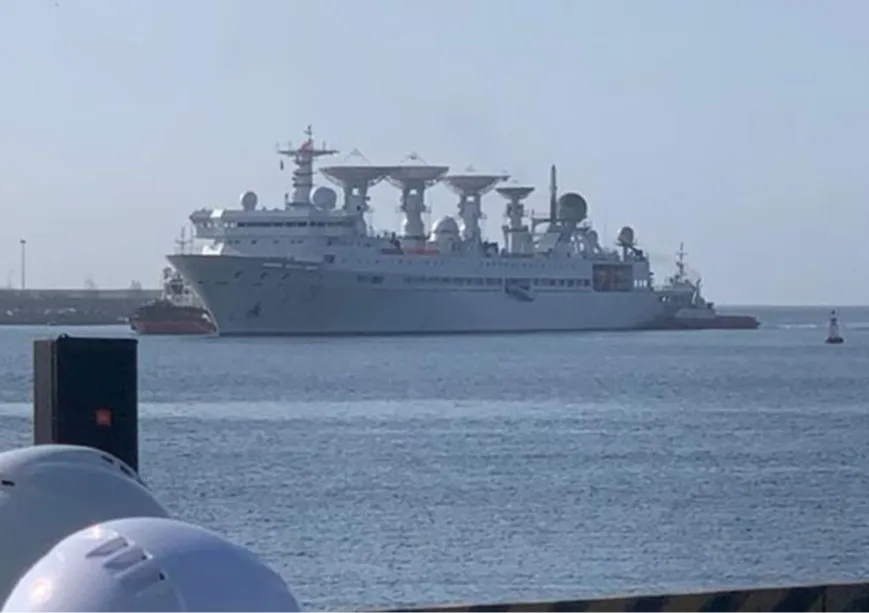
A moratorium to minimise China’s research in Sri Lankan waters was declared at the start of the year. China, despite this setback, has been pushing its geostrategic ambition by driving Sri Lanka towards Myanmar and engaging its Buddhist soft power diplomacy. This push comes amidst the recent Belt and Road Initiative scale-up proposed by China that links an economic corridor towards an island in the Indian Ocean, a conduit created through Sri Lanka facilitating China’s energy pipeline built in Myanmar.
On 19 December 2023, the Sri Lankan government declared an immediate moratorium of one year on foreign vessels conducting research in the island’s Exclusive Economic Zone (EEZ). It was declared after the arrival of the Chinese research vessel Shi Yang 6 on 25 October. Further, the moratorium conflicted with an already agreed upon research understanding with Sri Lanka’s National Aquatic Resources Research and Development Agency (NARA) despite security concerns raised by New Delhi. NARA insisted that joint research should be allowed and was keen to undertake collaborative research aboard the Chinese vessel.
The Sri Lankan government declared an immediate moratorium of one year on foreign vessels conducting research in the island’s Exclusive Economic Zone (EEZ).
The present backtracking by the Wickremesinghe regime was a poor analysis of security concerns. The twin reasons explained by the government to declare the moratorium were the upcoming 2024 elections and the lack of time for capacity development for the host agency to accommodate such research activity. Both these reasons remain far from the actual security threat posed by the Chinese vessels to Sri Lanka and India. While the moratorium would satisfy India, China will read this reversal of a commitment by the Wickremesinghe regime to accommodate Chinese research vessels as a weak move. The consequence of the knee-jerk policy manoeuvre by the government will affect its ties.
There is also another external danger when disappointing China. This was seen in the Chinese-funded Myitsone Dam project which was suspended since 2011. The earlier MoU signed with China to construct the dam did not consider environmental and human factors. The Irrawaddy River and its sacred significance to locals is considerable. The ecological damage displacing approximately 12,000 people was not considered when committing to the MoU. The suspension and reversal of the decision upset Beijing.
Weeks before the moratorium, the Special Envoy of Xi Jinping and State Councillor, Shen Yiqin, visited Sri Lanka to meet Sri Lankan President Wickremesinghe. Yiqin communicated the message that Beijing’s strategic circle has drawn Sri Lanka and Myanmar together, connecting Belt and Road Initiative (BRI) ports and economic corridors. “China is also prioritising the extension of the China-Myanmar Economic Corridor to Sri Lanka”, stated Yiqin. President Wickremesinghe accepted the BRI proposal connecting Sri Lanka with Myanmar, seeing the economic benefit. He said “Countries such as Sri Lanka, participants in the BRI, are prepared to embark on the second phase of the initiative, which is expected to make a more substantial economic contribution.”
Yiqin communicated the message that Beijing’s strategic circle has drawn Sri Lanka and Myanmar together, connecting Belt and Road Initiative (BRI) ports and economic corridors.
There are two reasons for tying Sri Lanka with the eastern Indian Ocean using Myanmar’s ‘China-Myanmar Economic Corridor (CMEC)’ over Pakistan’s China-Pakistan Economic Corridor (CPEC). First, using the Regional Comprehensive Economic Partnership (RCEP), President Wickremesinghe prioritised East Asia and ASEAN trade as a solution to reinvigorate the Sri Lankan economy. China sees this as an opportunity to support Wickremesinghe’s policy to connect Srilanka with Southeast Asian economies, while simultaneously pushing for its own strategic objective of connecting BRI Kyaukphyu port and Hambanthota port closer. This is to find an alternative for the Malacca Strait and mitigate China’s Malacca Dilemma.
China’s attempt to connect Sri Lanka and Myanmar is due to the India-backed Sittwe port development, a containment strategy to protect the Chinese-funded Kyaukphyu port at the same coastline. The Chinese expansion connecting BRI infrastructure will continue by winning the political elites in Sri Lanka and Myanmar despite the surrounding geopolitics. The delay in the progress of the Sittwe Port development compared to the Kyaukphyu Port has already impacted the public perception in Sri Lanka of India. The Chinese have already connected the gas supply line to mainland China through the Kyaukphyu port.
Second is the Theravada Buddhist cultural connection between Sri Lanka and Myanmar. It will glue the nations closer through China’s Global Civilizational Initiative (GCI). The Sri Lanka-Myanmar connection is also a viable option, compared to Sri Lanka-Pakistan due to the Buddhist religious connection. Theravada Buddhism, which dominates the population in Sri Lanka and Myanmar, is a perfect platform for China to carry out the Buddhist Belt and Road Initiative (B-BRI) of its larger GCI project.
The Chinese expansion connecting BRI infrastructure will continue by winning the political elites in Sri Lanka and Myanmar despite the surrounding geopolitics.
Surprisingly, China has moved from a non-religious communist regime towards resurrecting Confucianism which was buried by their communist leader, Mao Zedong, during the Cultural Revolution. The Red Guards destroyed Confucian temples, burnt texts, and desecrated the sage’s tomb. President Xi has taken an alternative route to Mao. He has accepted the Confucian root of Chinese culture and married it with the Marxist ideology—a strategy to win many Asian nations with its “shared future” vision. This propaganda is evident from the new television series “When Marx Met Confucius”. The CCP sinicisation project through ‘soft power’ aims to restore confidence in China’s commitment towards the common good in contrast to Western countries.
Buddhism in BRI (B-BRI)
At present, soft power diplomacy through Buddhism is also being carried out with the approval of the CCP alongside infrastructural diplomacy. China is projected as a benevolent power to improve lives through Buddhism via the GCI and thus, as part of its larger soft power strategy, China is using religion to promote its soft power in Sri Lanka.
The eighth edition of the South China Sea Buddhism Roundtable took place in Sri Lanka in December 2023, under the theme “Walking Together in Harmony and Gathering the Wisdom of the Silk Road.” More than 400 monks, scholars, government officials, and representatives from 25 countries attended the forum. The Rajapaksa brothers—the former president and prime minister—were among the participants. The meetings attempted to connect Han Chinese, Chinese Tibetan, and Theravada Buddhism. Mutual learning and enhancing people-to-people connectivity for a peaceful South China Sea were the underlying mission of the forum. Yin Shun, Vice President of the Buddhist Association of China, was a critical actor at the conference and is a member of the Chinese People’s Political Consultative Conference (CPPCC). Dr Gerry Groot observes that ‘representation in the CPPCC is usually a reward for cooperation with China’s United Front Work Department (UFWD)’, a vital department of the CCP Central Committee. President Xi called the UFWD one of the CCP’s “magic weapons”, as it managed to increase its members to 40,000 and run by a Politburo member. According to a CSIS report, UFWD is identified as a valuable tool for political warfare used on several targets, including important religious figures in many countries, including Sri Lanka. China’s UFWD engages in soft power diplomacy through Buddhism to win political elites, religious leaders, and the public. It is an innovative strategy that will work with a Buddhist majority. It is strategic to use a Buddhist narrative to push forward geopolitical and geoeconomic ambitions in the region.
Sri Lanka’s moratorium on research vessels will temporarily limit Chinese research in its waters. However, the main concern for the Sri Lankan policy circle is how they would deter the geostrategic expansion of China. The proposal to connect Sri Lanka with Myanmar was accepted by Sri Lankan leadership without any long-term consideration or clear understanding of the strategic implications.
Asanga Abeyagoonasekera is an international security and geopolitics analyst and strategic advisor from Sri Lanka.
The views expressed above belong to the author(s). ORF research and analyses now available on Telegram! Click here to access our curated content — blogs, longforms and interviews.




 PREV
PREV


